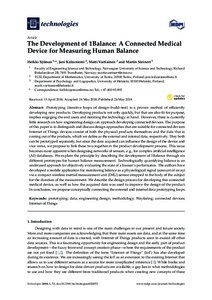The Development of 1Balance: A Connected Medical Device for Measuring Human Balance
Sjoman H; Kalasniemi J; Vartiainen M; Steinert M
The Development of 1Balance: A Connected Medical Device for Measuring Human Balance
Sjoman H
Kalasniemi J
Vartiainen M
Steinert M
MDPI
Julkaisun pysyvä osoite on:
https://urn.fi/URN:NBN:fi-fe2021042719461
https://urn.fi/URN:NBN:fi-fe2021042719461
Tiivistelmä
Prototyping (iterative loops of design-build-test) is a proven method of efficiently developing new products. Developing products not only quickly, but that are also fit for purpose, implies engaging the end users and iterating the technology at hand. However, there is currently little research on how engineering design can approach developing connected devices. The purpose of this paper is to distinguish and discuss design approaches that are suitable for connected devices. Internet of Things devices consist of both the physical products themselves and the data that is coming out of the products, which we define as the external and internal data, respectively. They both can be prototyped separately, but since the data acquired can influence the design of the device and vice versa, we propose to link these two together in the product development process. This issue becomes more apparent when designing networks of sensors, e.g., for complex artificial intelligence (AI) databases. We explain the principle by describing the development of 1Balance through six different prototypes for human balance measurement. Technologically quantifying balance is an underused approach for objectively evaluating the state of a human's performance. The authors have developed a mobile application for monitoring balance as a physiological signal (amount of sway) via a compact wireless inertial measurement unit (IMU) sensor strapped to the body of the subject for the duration of the measurement. We describe the design process for developing this connected medical device, as well as how the acquired data was used to improve the design of the product. In conclusion, we propose conceptually connecting the external and internal data prototyping loops.
Kokoelmat
- Rinnakkaistallenteet [27094]
